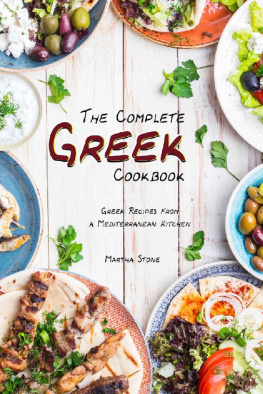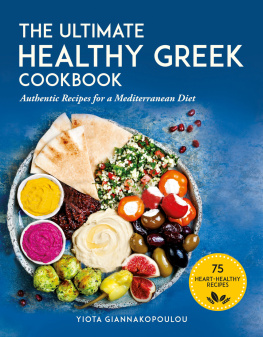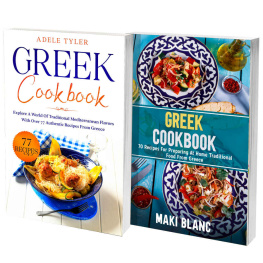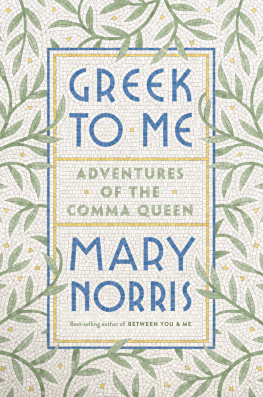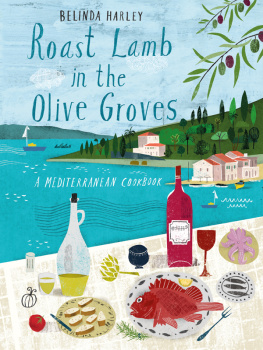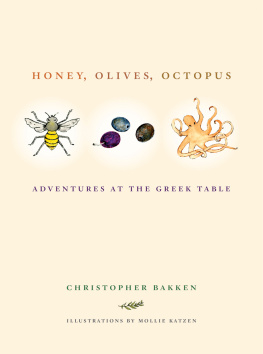THAT HUNGER
MAY HATE YOU, AND
VENERABLE DEMETER,
RICHLY CROWNED,
MAY LOVE YOU AND
FILL YOUR BARN
WITH FOOD
HESIOD, CA. 700 B.C.E.
ADVENTURES IN GREEK COOKING
The Olive and the Caper
SUSANNA HOFFMAN
IN COLLABORATION WITH VICTORIA WISE
WORKMAN PUBLISHING NEW YORK
Copyright 2004 by Susanna Hoffman
Color photography 2004 by Susan Goldman
All rights reserved. No portion of this book may be reproducedmechanically, electronically, or by any other means, including photocopyingwithout written permission of the publisher. Published simultaneously in Canada by Thomas Allen & Son Limited.
eISBN 9780761164548
Cover design by Paul Hanson
Color photographs by Susan Goldman
Food styling by Victoria Granof
Prop styling by Sara Abalon
New illustrations by Meredith Hamilton
Workman books are available at special discounts when purchased in bulk for premiums and sales promotions as well as for fund-raising or educational use. Special editions can also be created to specification. For details, contact the Special Sales Director at the address below.
Workman Publishing Company, Inc.
225 Varick Street
New York, NY 10014-4381
www.workman.com
The sanctuary of Athena Pronaia looms among the wild herbs and caper vines of Delphi.

Time for a sweet, foamy afternoon coffee in a Cyclades island coffeehouse.
In a clay pot unchanged in shape since Homers time, the flowers of Macedonia flourish.
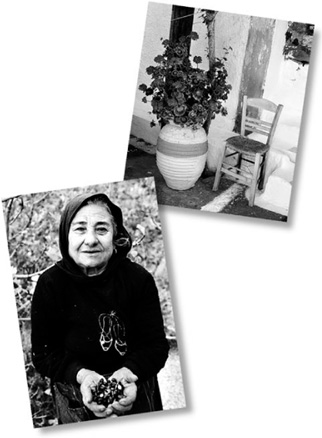
A Maniot woman of the Peloponnesos offers a double handful of plump olives from her orchard.
TO VICTORIA WITHOUT WHOM I WOULD NEVER HAVE PLUCKED THIS BOOK FROM THE EMBERS, WITH LOVE AND ENDLESS THANKS

AND TO THE ELEVEN OTHERS OF THE OPTIMISTS CLUB WHO HELPED ONE ANOTHER RISE AGAIN
ARLEEN, CLARA, CAROL, ELLIE, INJA, JOAN, JUDITH, KATHY, MARILYN, ROBBIE, SANDY

acknowledgments

I HAVE NOT COUNTED WHETHER THIS BOOK DEMANDED EXACTLY TWELVE MOMENTOUS LABORS, BUT IT ENTAILED MANY, AND, CONSIDERING ITS TWOFOLD HISTORY, COULD SURELY BE CALLED A HERCULEAN EFFORT. (THE GREEKS WOULD SAY ERAKLEAN.) I DID NOT ACCOMPLISH IT ALONE. AT MY SIDE WERE MANY HEROES, AND MY GRATITUDE GOES TO THEM ALL.
Tryfon Tzifas kept my Greek alive, joyously discussed with me the curiosities that arose, and helped me untangle enigmatic words and translate passages. John Pardales must be Dionysoss agent with his impeccable knowledge of Greek wine. Jan Brukman, friend and fellow, while lending his ear to the anthropology, kept his eye directed to the food. Bob DeBarge helped me trim a love of history and detail that would have turned many of the chapters tales into tomes. Martha Casselman, my wonderful agent, had the patience of Hestia while letting the book bake and rebake.
Suzanne Rafer, divine editor, metamorphosed the work into a whole with a goddesss touch and the Olympian help of Ann Ffolliott and Kathie Ness. Thanks, too, to Paul Hanson and Lisa Hollander for a beautiful cover and interior design, Leora Kahn for finding photos that perfectly capture the food and spirit of Greece, and photographer Susan Goldman, food stylist Victoria Granof, and prop stylist Sarah Abalon for making the dishes in the color section so luscious. My diadem is also off to Kate Tyler and Katie Workman, who wonderously sport the winged sandals of message-bearing Hermes, along with all the other miracle-makers in Workmans publicity, sales, and marketing departments. Above all, a special bow to the Zeus of this whole pantheon, Peter Workman.
Over the long and double history of this book, a Greek chorus of supporters include Cielo Arango de Luzarraga, Sandy Ashton, Deborah and Levi Bendele, Suzanne Bohning, Larry Bolder, Jim Botsakos, Craig Brock and David Ramirez, Dawn Bryan, Argene Klonaris Carter, Bill Chambers, Joe Cooley, Richard Cowan and Kathy Collins, Rena Down, Gale Hayman, Marida Hollos, Gordon Jacobs, Michelle Kodis, Karin and Tim Knowles, Aglaia Kremezi, Gail and Stuart Lake, Jake Linzinmeir, Robert Mandel, Susan Mitchell, Paula Moss, Alan Petraske, Lisa Rich and Robbie Greenberg, Susanna Smith, Bernie Weintraub, Marshall Whiting, Deborah Wolf, Paula Wolfert, Mary Woods, and a true legion of Greek village and city friends, especially Markella Damigos, her daughter, Maria, and her sisters, Paraskevi and (in memoriam) Koko; Tousa Damigos and her parents, Markos and Theodosia; Markos M. Damigos; Eirini Kafouros; Stelios Vougioucalos, and my many friends at the Greek Fulbright Foundation.
My deepest gratitude also goes to my many compassionate colleagues at the 1991 Symposium on The Foods and Wine of Greece who succored me when calamity struck. Though many people helped me recover, and I am grateful to you all, two steadfast Titans especially carried me through: Karen Joffee and above all, Stephen Hettenbach. The Gaia of this travail was and is, of course, Victoria Wise, who not only helped me recover, but helped recover this book.
My son, Jesse Aratow, my ever valiant champion, remains a constant source of strength. Like an Artemis with arrows of clean writ, my daughter, Gabriella Aratow, put tremendous time, effort, and talent into polishing the work. Heracles means Heras Glory. Gabriella is mine.
contents

PART ONE
HONORED DRINKS, SMALL DISHES, AND SAVORY PIES
Of utmost importance in Greece, each drink is special, from glasses of crystal clear water and fruitade to anise-flavored ouzo and piney retsina; from cups of rich, freshly ground coffee to fragrant tea
A lavish gallery of little foods to go with drinks, mezedes appear at all times of the day as well as at the start of the meal. They can be as simple as a piece of cheese or a few olives, or more complextasty meatballs, Russian salad, marinated shrimp, stuffed grape leaves, taramasalata, and houmus. All tease and appease the appetite

Flaky, fragrant, filled savory filo-crusted pies are served both as mezedes and as main courses throughout Greece. It is easy to re-create the big filo pies baked in square or round pans, as well as the little pies shaped like cigars or snails
PART TWO
THE BANQUET OF DISHES
Crunchy-crusted country bread, lighter city bread, dense bread rings and dried paximadia, versatile pita, breads studded with olives, garlic, and lemon zest, Easter bread with its red-dyed eggs, fruit-filled breads for Christmasno Greek meal or snack lacks bread.
From ancient times to modern, hot soups, cold soups, and thick soups have figured on the Greek menu. Filled with beans, lentils, bits of meat or fish, vegetables, noodles or rice, bread, and a splash of flavorful olive oil, soups are frequently a key stone dish on the table
Next page

